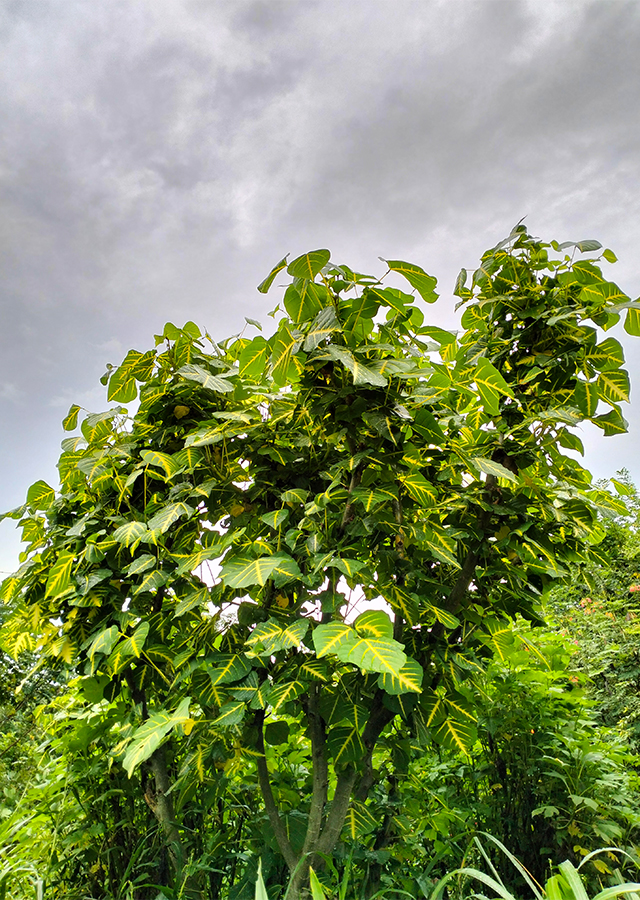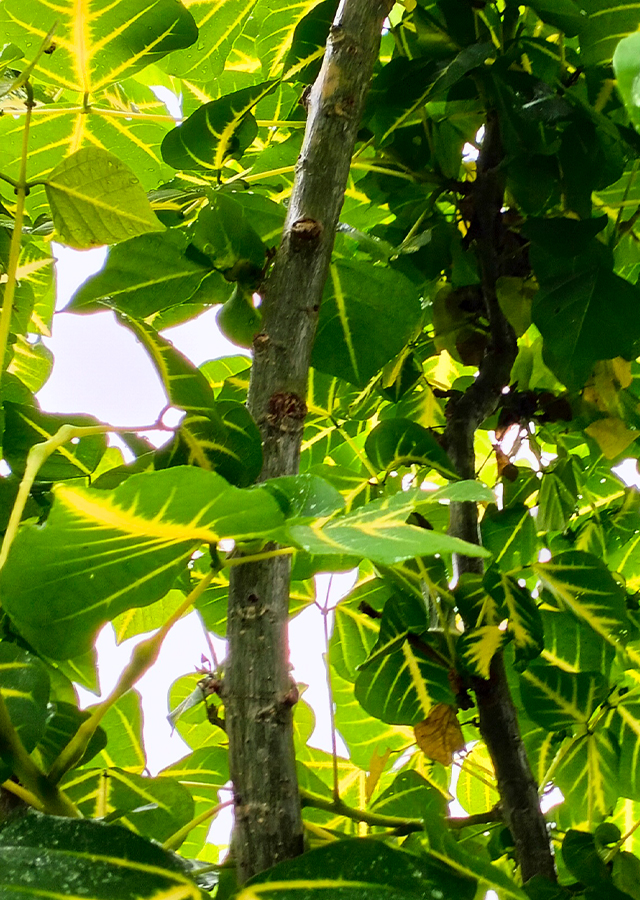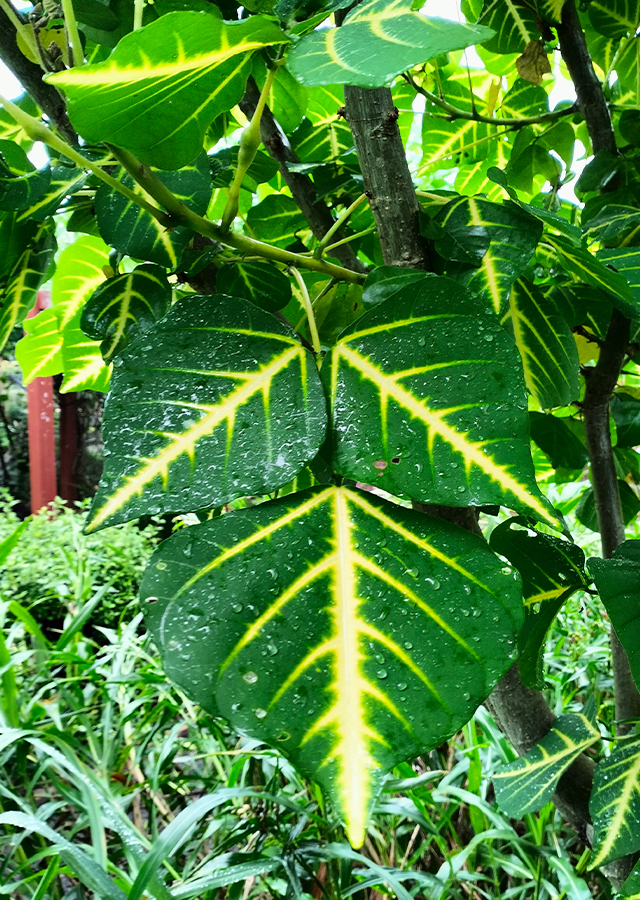Indian Coral Tree
Erythrina variegata L.
Fabaceae
Location in our garden
Principal



Synonym
Chirocalyx candolleanus Walp.
Chirocalyx divaricatus (Moc. & Sessé ex DC.) Walp.
Chirocalyx indicus (Lam.) Walp.
Habitus
Trees. A large deciduous perennial tree that can grow up to about 27 m tall
Part Used
Leaves
Bark
Roots
Growing Requirements
Full Sunshine
Habitat
Coastal
Roadside
Shrublands
Terrestrial
Overview
Erythrina variegata is native to North Africa - Tanzania, Indian Ocean Islands, India, China, Myanmar, Malaysia, Indonesia and the Pacific Islands. Genus Erythrina is from the Greek word "erythros" which means "red" and refers to the flowers. Species variegata means irregularly coloured and refers to the leaves. It is used as animal food, a poison, a medicine and invertebrate food, has environmental uses and social uses and for fuel and food. The pulp wood is used as source of pulp for making paper. Fiber is acceptable for length, flexibility, slenderness ration, and low Rankel's ration. In Indonesian folk medicine, it is used for treatment of cancer. Environmental uses is for agroforestry, boundary, barrier or support, and soil improvement.
Vernacular Names
Arbre au corail (French), Indischer Korallenbaum (German), Dego (Japanese), Badapu (India), Dedap (Malay), Penglay-kathit (Burmese), Balbal (Papua New Guinea), Thong laang laai (Thai), Dapdap (Tagalog-Philippines), Hai tong pi (Chinese), Cây lá vông (Vietnamese).
Agroecology
Grows best in tropical, subtropical and warm climates at an altitude of up to 1,200 m above sea level. Thrives in areas where the annual rainfall ranges from 800-1,500 mm, the average temperature is around 20 - 32 °C. Succeeds in moderately fertile and well-drained soil. The plant is tolerant of salt laden winds and moderate salinity in the soil. Prefers a pH in the range of 5-7, and tolerates 4.5 - 7.5.
Morphology
- Root - taproot system.
- Stem - bark surface has grooves, the branches and the branchlets stout and armed with short, few to many sharp prickles.
- Leaves - compound leaves with light green and yellow variegation, each leave has 3 ovate leaflets about 4-25 cm long and 5-30 cm wide, terminal leaflet is the largest.
- Flowers - papillonaceous, large and numerous. Calyx is about 4 cm long and minutely 5-toothed at the tip, the mouth being very oblique. Petals are bright red and shorter than the calyx, the standard being 7-9 cm long and the wings and keels subequal. Stamens are 10, upper filaments free nearly to the base or more or less connate with others. Ovary many-ovuled, style incurved. Racemes terminal, hairy, dense and up to 2.5 cm long.
- Fruits - a long cylindrical pod about 10-45 cm long and contains up to 13 seeds.
- Seed - black or purple seeds.
Cultivation
- Generative propagation is by seed. Fresh seeds and harvested within 3-6 months, can be sown without special treatment. Germination rates are generally high and often 100%. Seeds older than 6 months take between 12-18 months to germinate. Soaking them in hot water, or scraping off the seed coat. The seeds will germinate in 8-10 days. Seedlings reach a height of 30-50 cm in 8-10 weeks.
- Vegetative propagation is by stem cutting. Large stem cuttings require stems 2-3 m long and 5 8 cm in diameter. Branch cuttings with terminal shoots are also sometimes used to obtain tall.
Chemical Constituents
Alkaloids (erythraline, hypaphorine, erythrinin, erybidin), fatty acid, coumarin, B-sitosterol, amino acids, organic acids, steroids, triterpenoids, flavonoids, saponins.
Traditional Medicinal Uses
- The bark is used to treat fever in Burma; liver problems in China; dysentery, cancer, and malaria in Indonesia; and intermittent fever in Indochina. The bark has also been used to treat rheumatism, as a painkiller in toothache and to promote the expulsion of phlegm from the respiratory passages.
- The leaves are used in Malaysia to improve appetite, to promote sleep, to control fever as well as to remove phlegm.
- In the Philippines, a sweetened decoction of bark and leaves used as expectorant.
- Roots are used for ophthalmia and skin diseases.
Part Used
Reference Sources
- CABI. (2022). Invasive Species Compendium: Erythrina variegata (Indian coral tree). https://www.cabi.org/isc/datasheet/22055. 16-08-2022.
- Fern, Ken. (2022). Useful Tropical Plants: Erythrina variegata. http://tropical.theferns.info/viewtropical.php?id=Erythrina%20variegata. 16-08-2022.
- Kew Royal Botanic Gardens. (No date). Plant of the World Online: Erythrina variegata L.. https://powo.science.kew.org/taxon/urn:lsid:ipni.org:names:494614-1#descriptions. 16-08-2022.
- National Park of Singapore. (2021). Flora Fauna Web: Erythrina variegata L.. https://www.nparks.gov.sg/florafaunaweb/flora/5/6/5622. 16-08-2022.
- Stuartxchange. (2020). Philippine Medicinal Plants: Dapdap-Erythrina variegata Linn. http://www.stuartxchange.org/Dapdap.html. 16-08-2022.


